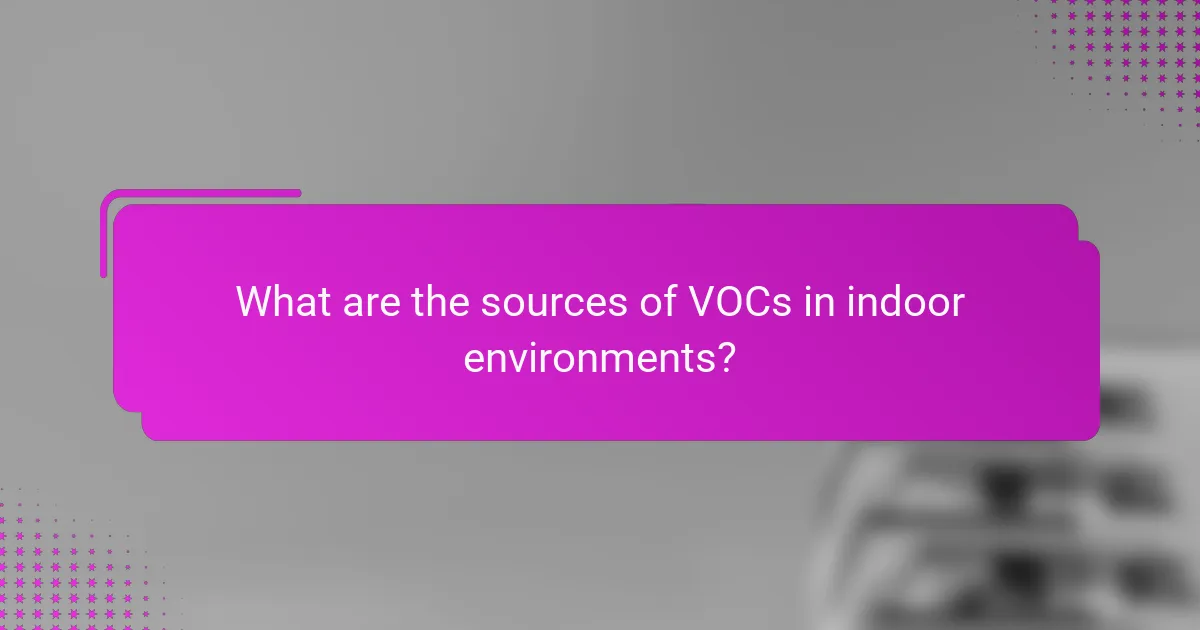Volatile organic compounds (VOCs) are prevalent in indoor environments, originating from everyday items such as cleaning agents, building materials, and personal care products. Their presence can adversely affect air quality and human health, leading to both immediate and long-term health issues. To combat VOC exposure, it is crucial to adopt effective mitigation strategies, including enhancing ventilation and selecting low-VOC alternatives.

What are the sources of VOCs in indoor environments?
VOCs, or volatile organic compounds, are emitted from a variety of sources within indoor environments, significantly impacting air quality. Common sources include household products, building materials, office equipment, cleaning agents, and personal care products.
Household products
Many household products release VOCs, including paints, varnishes, and adhesives. These items can emit harmful gases during application and even after they have dried, contributing to indoor air pollution.
When selecting household items, look for those labeled as low-VOC or no-VOC to minimize exposure. Proper ventilation during and after use can also help reduce VOC concentrations.
Building materials
Building materials such as plywood, particleboard, and certain insulation types often contain formaldehyde and other VOCs. These materials can off-gas for years after installation, affecting indoor air quality.
Choosing low-emission building materials and ensuring adequate ventilation during construction can mitigate these risks. Consider using natural materials like bamboo or reclaimed wood as alternatives.
Office equipment
Office equipment, particularly printers, copiers, and some types of furniture, can emit VOCs. These emissions may occur during operation and can linger in the air, especially in poorly ventilated spaces.
To reduce exposure, opt for energy-efficient devices that comply with environmental standards. Regular maintenance and ensuring good airflow in office areas can also help manage VOC levels.
Cleaning agents
Many cleaning agents contain VOCs, which can be released into the air during use. Products like air fresheners, disinfectants, and surface cleaners often contribute to indoor air pollution.
Choosing eco-friendly or green cleaning products can significantly reduce VOC emissions. Additionally, using these products in well-ventilated areas can help minimize inhalation of harmful compounds.
Personal care products
Personal care products, including perfumes, deodorants, and hair sprays, can also be significant sources of VOCs. These products often contain synthetic fragrances and preservatives that release volatile compounds into the air.
To limit exposure, consider using fragrance-free or natural alternatives. Applying personal care products in well-ventilated spaces can further reduce indoor VOC concentrations.

How do VOCs impact human health?
Volatile Organic Compounds (VOCs) can significantly affect human health, leading to a range of immediate and long-term health issues. Exposure to VOCs often occurs through inhalation, skin contact, or ingestion, with effects varying based on the level and duration of exposure.
Short-term health effects
Short-term exposure to VOCs can cause a variety of health problems, including headaches, dizziness, and respiratory issues. Symptoms may appear quickly after exposure and can vary in intensity based on individual sensitivity and the concentration of VOCs in the environment.
Common sources of short-term exposure include household products such as paints, solvents, and cleaning agents. Ensuring proper ventilation while using these products can help mitigate immediate health risks.
Long-term health risks
Long-term exposure to VOCs is associated with more severe health risks, including chronic respiratory diseases, liver damage, and even certain types of cancer. The cumulative effect of prolonged exposure can lead to significant health deterioration over time.
Regulatory agencies, such as the Environmental Protection Agency (EPA), have established guidelines to limit VOC emissions in various industries to protect public health. Adhering to these regulations is crucial for reducing long-term health risks.
Vulnerable populations
Certain groups are more susceptible to the adverse effects of VOCs, including children, the elderly, and individuals with pre-existing health conditions. These populations may experience heightened sensitivity to the health impacts of VOC exposure.
To protect vulnerable individuals, it is essential to minimize their exposure to VOCs in both residential and occupational settings. Implementing strategies such as using low-VOC products and improving indoor air quality can significantly benefit these at-risk groups.

What mitigation strategies can reduce VOC exposure?
To reduce VOC exposure, implementing effective mitigation strategies is essential. These strategies include improving ventilation, using low-VOC products, maintaining HVAC systems, and incorporating indoor plants for air purification.
Improving ventilation
Enhancing ventilation is a straightforward way to decrease VOC levels indoors. This can be achieved by opening windows, using exhaust fans, or installing air exchange systems that bring in fresh outdoor air.
Consider using mechanical ventilation systems with filters that can capture airborne pollutants. Aim for a ventilation rate that meets or exceeds local building codes to ensure adequate air exchange.
Using low-VOC products
Opting for low-VOC products is crucial in minimizing indoor air pollution. Look for paints, adhesives, and cleaning supplies labeled as low-VOC or zero-VOC, which typically emit fewer harmful chemicals.
When shopping, check for certifications such as Green Seal or GREENGUARD, which indicate compliance with stringent VOC emission standards. This choice not only improves air quality but also supports healthier living environments.
Regular maintenance of HVAC systems
Regular maintenance of HVAC systems helps ensure they operate efficiently and effectively filter out VOCs. Change filters every few months and schedule professional inspections annually to keep the system in top condition.
Consider upgrading to high-efficiency particulate air (HEPA) filters, which can capture smaller particles, including some VOCs. This proactive approach can significantly improve indoor air quality.
Indoor plants for air purification
Incorporating indoor plants can naturally help purify the air and reduce VOC levels. Certain plants, such as spider plants, peace lilies, and snake plants, are known for their air-cleaning properties.
To maximize their effectiveness, place several plants in different areas of your home. While they won’t eliminate VOCs entirely, they can contribute to a healthier indoor environment alongside other mitigation strategies.

What regulations exist for VOC emissions?
Regulations for VOC emissions are designed to limit the release of volatile organic compounds into the atmosphere, which can harm air quality and public health. These regulations vary by country and region, with specific guidelines established by governing bodies to control emissions from various sources.
EPA regulations
The Environmental Protection Agency (EPA) in the United States sets national standards for VOC emissions through various programs, including the Clean Air Act. These regulations target specific industries, such as automotive and manufacturing, requiring them to implement measures that reduce VOC emissions to acceptable levels.
For example, the EPA has established National Emission Standards for Hazardous Air Pollutants (NESHAP) that include limits on VOC emissions from specific processes. Companies must monitor their emissions and report compliance, often leading to the adoption of cleaner technologies and practices.
State-level initiatives
Many U.S. states have their own regulations that complement or exceed federal guidelines on VOC emissions. These state-level initiatives often address local air quality concerns and may include stricter limits or additional requirements for businesses. States like California have implemented comprehensive programs to reduce VOCs from consumer products and industrial processes.
For instance, California’s Air Resources Board has established stringent regulations on VOC content in paints and solvents, which has led to significant reductions in emissions. Businesses operating in these states must stay informed about local regulations to ensure compliance and avoid penalties.

How can businesses implement VOC reduction strategies?
Businesses can implement VOC reduction strategies by adopting practices that minimize volatile organic compound emissions in their operations. This involves assessing current sources of VOCs, training employees, and integrating effective technologies and processes to reduce emissions.
Employee training programs
Implementing employee training programs is essential for reducing VOC emissions in the workplace. These programs should educate staff about the sources and effects of VOCs, as well as the importance of following safety protocols and using materials that emit fewer VOCs.
Training sessions can include hands-on demonstrations, workshops, and informational materials that highlight best practices. For example, employees can learn to identify high-VOC products and understand how to use them safely or switch to low-VOC alternatives.
Regular refresher courses and updates on new regulations or technologies can keep employees informed and engaged. Businesses should encourage feedback from staff to continuously improve training effectiveness and address any challenges encountered in implementing VOC reduction strategies.


